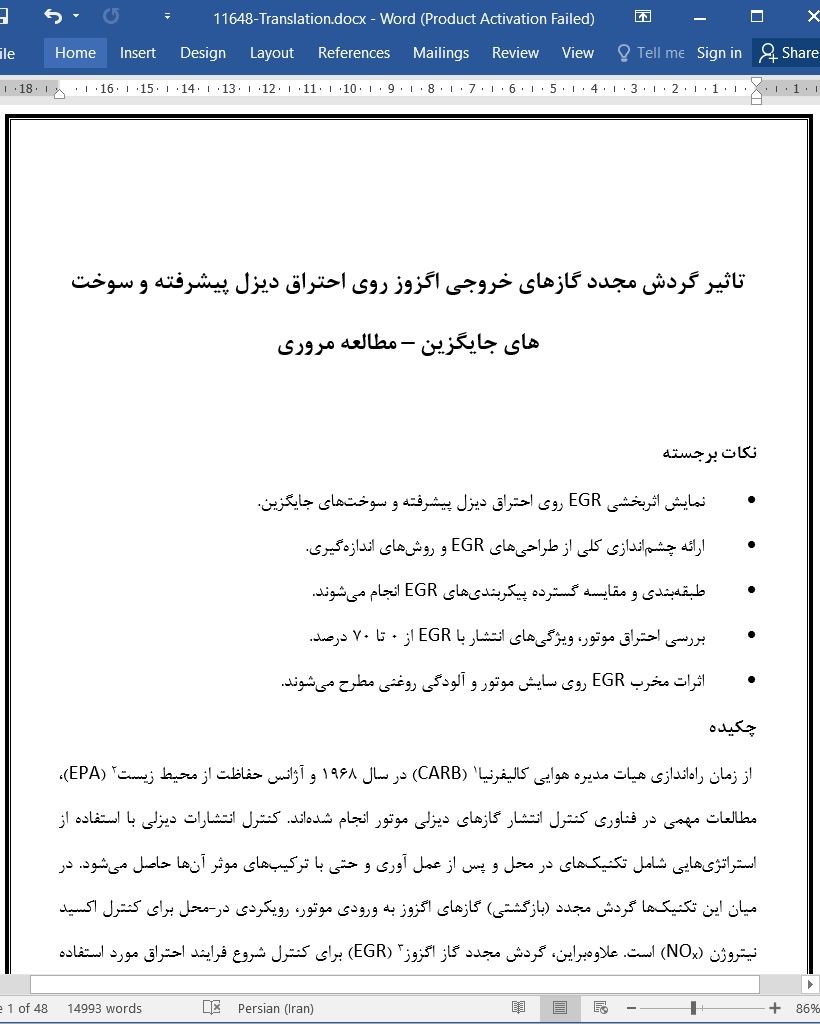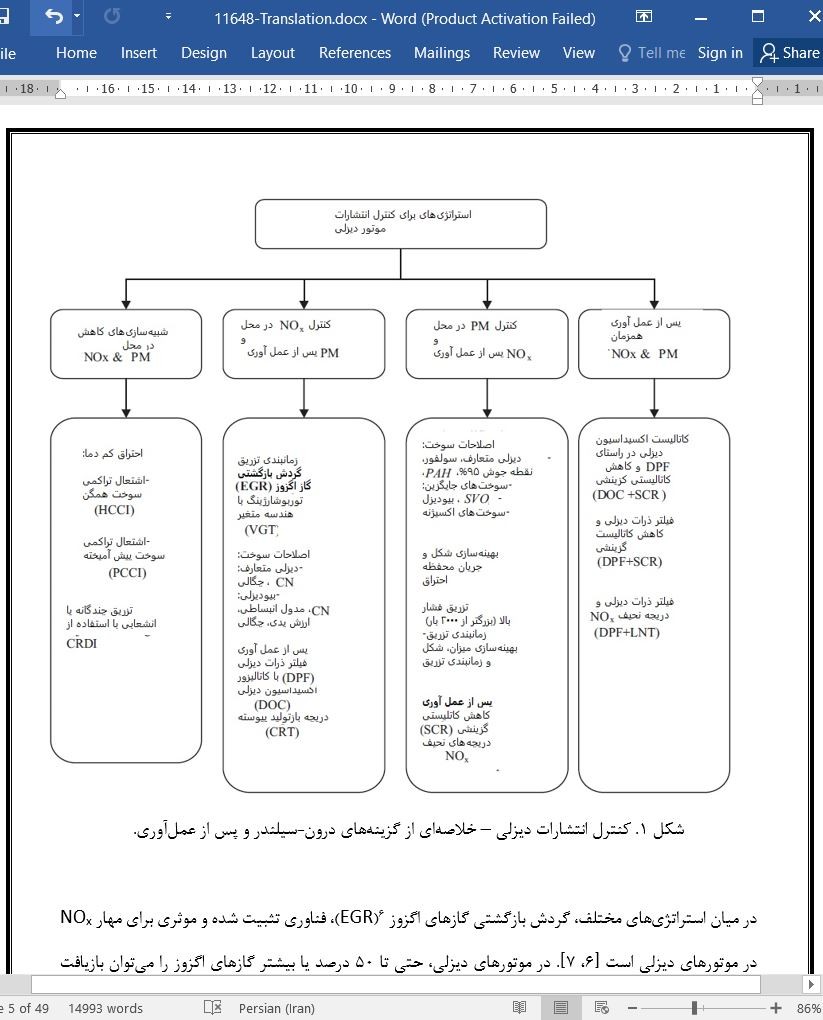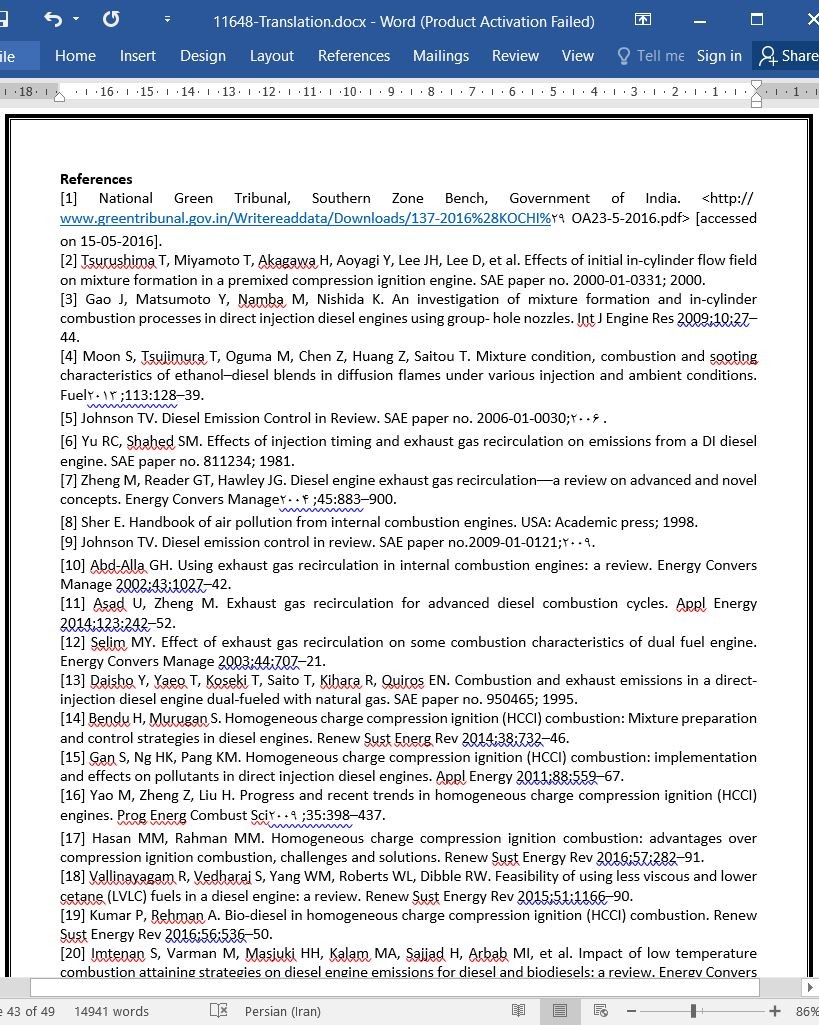
تاثیر گردش مجدد گازهای خروجی اگزوز روی احتراق دیزل پیشرفته و سوخت های جایگزین
چکیده
از زمان راهاندازی هیات مدیره هوایی کالیفرنیا (CARB) در سال 1968 و آژانس حفاظت از محیط زیست (EPA)، مطالعات مهمی در فناوری کنترل انتشار گازهای دیزلی موتور انجام شدهاند. کنترل انتشارات دیزلی با استفاده از استراتژیهایی شامل تکنیکهای در محل و پس از عمل آوری و حتی با ترکیبهای موثر آنها حاصل میشود. در میان این تکنیکها گردش مجدد (بازگشتی) گازهای اگزوز به ورودی موتور، رویکردی در-محل برای کنترل اکسید نیتروژن (NOx) است. علاوهبراین، گردش مجدد گاز اگزوز (EGR) برای کنترل شروع فرایند احتراق مورد استفاده قرار گرفته است. در مطالعه حاضر، اهمیت EGR برای احتراق دیزلی پیشرفته مانند اشتعال تراکمی سوخت همگن (HCCI) یا سیستم احتراق کم دما (LTC) و الزام EGR به استفاده از سوختهای جایگزین مورد بحث قرار میگیرند. به منظور تسهیل شناخت بهتر، اثرات نامطلوب EGR، تاثیر EGR روی سایش موتور دیزلی و تضعیف روغنکاری نیز مطرح میشوند.
1. پیشگفتار
در طول پنج دهه گذشته، جمعیت وسایل نقلیه در سراسر جهان به طور قابل توجهی افزایش یافته است. نگرانی در مورد آلودگی ناشی از وسایل نقلیه به طور پیوسته پس از اپیزود لس آنجلس در دهه 1990 افزایش یافته است. به خوبی میدانیم که انتشارات وسایل نقلیه با توجه به نوع موتور، شرایط عملیات، و سوخت مورد استفاده، متغیر است، و لازم است که همه این جنبهها برای کاهش آنها به طور همزمان مورد بررسی قرار گیرند. شدت آلودگی موتور بستگی به غلظت و زمان در معرض قرارگیری دارد و به شدت روی سلامت انسان تاثیر میگذارد. با توجه به مزیت اقتصادی ذاتی سوخت، موتورهای دیزلی، تهاجمهایی را در کاربردهای خودرو علاوهبر دامنه ثابت معمول خود ایجاد کردهاند. با این حال، وسایل نقلیهای که با سوخت دیزلی کار میکنند منبع اصلی انتشارات NOx و ذرات معلق و مسئول بدتر شدن کیفیت هوای محیط هستند. بسیاری از کشورها مانند برزیل، چین، سریلانکا، دانمارک، و پاریس در فرایند حذف وسایل نقلیه دیزلی و اجرای مالیاتهای سنگین و مالیات روی چنین وسایل نقلیهای قرار دارند. به تازگی دولت هند، ثبت نام خودروهای دیزلی با ظرفیت 2000 CC و بالاتر را در شهرهای خاص ممنوع کرده است [1].
Abstract
Ever since the establishment of the California Air Resources Board (CARB) in 1968 and Environmental Protection Agency (EPA) in 1970, significant strides have been made in diesel engine emission control technology. The diesel emission control is being achieved using strategies involving in-situ and after-treatment techniques and even with their effective combinations. Among these techniques, recirculation of the exhaust gases back to the engine inlet is an in-situ approach for Nitrogen Oxides (NOx) control. Moreover, exhaust gas recirculation (EGR) has been used for controlling the onset of combustion process. In the current review, the importance of EGR for advanced diesel combustion like homogeneous charge compression ignition (HCCI) or low-temperature combustion (LTC) system and the requirement of EGR with the use of alternate fuels are discussed. In order to facilitate better understanding, the adverse effects of EGR, the impact of EGR on diesel engine wear and lube oil deterioration is also highlighted.
1. Introduction
Over the last five decades, the vehicle population across the globe has grown significantly. The concern over vehicular pollution increased steadily after 1960s Los Angeles episode. It is wellknown that vehicular emissions vary with engine type, operating conditions and fuel utilized, and all these aspects need to be addressed simultaneously for their abatement. The severity of engine pollutant depends on their concentration and exposure time and severely affects human health. Owing to inherent fuel economy advantage, diesel engines have made inroads into automotive applications beside their usual stationary domain. However, the diesel fuel operated vehicles are the major source of NOx and particulate emissions and responsible for the deterioration of ambient air quality. Many countries like Brazil, China, Sri Lanka, Denmark and Paris are in the process of eliminating diesel vehicles and enforcing heavy taxes and levies on such vehicles. Recently, Indian government banned the registration of dieselrun private cars with capacity of 2000 CC and above in certain cities [1].
نکات برجسته
چکیده
فهرست
1. پیشگفتار
2. گردش بازگشتی گاز اگزوز
2.1. طراحی، پیکربندی و پنجره عملیاتی EGR
3. احتراق موتور پیشرفته
3.1. استراتژیهای آمادهسازی شارژ (سوخت) همگن
4. EGR برای مفاهیم احتراق موتور پیشرفته
5. EGR برای موتورهای با سوخت جایگزین
5.1 EGR برای موتورهای سوخت مایع جایگزین
5.2. EGR برای موتورهای با سوخت گازی جایگزین
6. تاثیر EGR روی آلودگی روغن موتور و سایش موتور
7. تاثیر EGR روی ویژگیهای ذرات دیزلی
8. نکات نتیجهگیری و جهات پژوهشی آینده
رفرنس
Abstract
1. Introduction
2. Exhaust gas recirculation
2.1. EGR design, configurations and operating window
3. Advanced engine combustion
3.1. Homogeneous charge preparation strategies
4. EGR for advanced engine combustion concepts
5. EGR for alternate fuelled engines
5.1. EGR for alternate liquid fuelled engines
5.2. EGR for alternate gaseous fuelled engines
6. Effect of EGR on engine oil contamination and engine wear
7. Effect of EGR on diesel particle characteristics
8. Concluding remarks and future directions
References
- ترجمه فارسی مقاله با فرمت ورد (word) با قابلیت ویرایش، بدون آرم سایت ای ترجمه
- ترجمه فارسی مقاله با فرمت pdf، بدون آرم سایت ای ترجمه



